
With the formal surrender of Imperial Japan on the 2nd of September 1945, World War II finally ended. The survivors of this horrific episode in human history had to pick up their lives with many loved ones and neighbors killed during the Japanese occupation and the almost one year of fight to retake the Philippines, starting on the 17th of October 1944 and ending on the 1st of September 1945. With the death of the exiled President Manuel Luis Molina Quezón (1878-1944) in America, leading to Sergio Osmeña Sr. (1878-1961) returning to the country as the President of Philippines on the 20th of October, 1944. While battles were happening around the archipelago, Pres. Osmeña took control of the government, on the 25th of February 1945, six days before Manila was liberated from Japanese control. Shifting from a War Cabinet to a new Commonwealth Government, Osmeña and his cabinet started plans for the rehabilitation of the many cities and municipalities that were devastated by the war, and the eventual independence of the Philippines.

Through Secretary of Finance and Reconstruction Jaime Hernández (1892-1986) and Secretary of Public Works and Communications Sotero Barte Cabahug (1891-1963), Pres. Osmeña wanted to reassemble the planning team that his predecessor, Pres. Quezón, to lead the planning of the reconstruction of Manila and other Philippine infrastructure and cities. Unfortunately the original team leader, Arch./Eng. Harry Talford Frost (1886-1943), passed away in Chicago; and Eng. Alpheus Daniel Williams (1887-1945) died shortly after rejoining the team. This left Arch. Louis P. Croft (1900-1978) in charge, while Arch. Juan Marcos Arellano expressed his intent in participating.

However, conflicts within the planning team and unfair negotiation between the Philippine and US governments forced Arch. Juan Marcos de Guzmán Arellano (1888-1960) to pull out of the rehabilitation program. Arch. Arellano wanted to be faithful to the plans instigated by Pres. Quezón and Arch. Frost, and keep the integrity of his own designs in the buildings that he had designed during the American Occupation of the Philippines (1898-1946). The planning team wanted to rush the rehabilitation and simplified the designs of all the buildings and structures that were to be reconstructed. At the same time, the US representatives lowered the budget estimate that would be spend for the rehabilitation, and were threatening of withholding its implementation if the Philippines would not enter into exclusive trade and security agreements with America.

While in the middle of negotiations with the US representatives, Pres. Osmeña had ordered Secretary Hernández, Secretary Cabahug, and Secretary of Defense Tomás Lluisma Cabili (1903-1957) to start the cleanup to the cities and the sorting and burying of the hundreds of thousands of dead, as the Greater Manila Area (now Metro Manila or the National Capital Region) was beginning to smell from the stench of rotting corpses. Much of the debris hauled from the damaged structures in Greater Manila were dumped into the Manila bay, as a part of a reclamation project of expanding the city.

Aside from the hundreds of thousands of the dead, there were more civilians who were injured by the war. However, most of the Manila hospitals destroyed by the fighting; while the remaining medical facilities still barely in operation were filled to the brim. To resolve this, Pres. Osmeña institutionalized an orthopedic hospital in Mandaluyong in 1945, with the help of the “Father of Philippine Orthopedics” Dr. Jose Valmonte de los Santos Sr. (1898-2000). This is now the National Orthopedic Hospital, which transferred from Mandaluyong to Banawe Street in 1963. At the same time, the Philippine military erected their Armed Forces of the Philippines Medical Center also in Mandaluyong to treat the injured soldiers and their families, but as the military hospital was moved to in permanent home in Barrio Pinyahan in 1947, renamed as the Colonel Victoriano Luna Medical Center.

To speed up the rehabilitation of the Greater Manila Area and its outlying towns, Pres. Osmeña ordered Arch. Croft to create a Metropolitan Thoroughfare Plan that would link many of the roads of the Greater Manila Area with the outlying provinces, to expedite the transport of goods and services throughout the region. On the 13th of June 1945, Arch. Croft worked with Eng./Arch. Antonio Cruz Kayanan (1911-1988) to propose a ten Radial Road and six Circumferential Road system to accomplish this. The ten Radial Roads routes would all start by “radiating” from Kilometer Zero at the flagpole in front of the monument of the National Hero Dr. José Protasio Rizal Mercado y Alonso Realonda (1861-1896) in Manila and connect to the provinces of Bataan, Batangas, Bulacan, Cavite, La Union, Laguna, Morong (now Rizal Province), Pampanga, Pangasinan, Tarlac, and Tayabas (now Quezon Province). The Circumferential Road system is comprised of six “circular” routes that link roads within the Greater Manila Area and its outskirts, which link the cities and municipalities of Antipolo (Rizal), Bacoor (Cavite), Biñan (Laguna), Cainta (Rizal), Caloocan, Dasmariñas (Cavite), Malabon, Makati, Mandaluyong, Manila, Marikina, Marilao (Bulacan), Meycauayan (Bulacan), Navotas, Parañaque, Pasay, Quezon, San Jose del Monte (Bulacan), San Juan, San Pedro (Laguna), Taguig, Taytay (Rizal), Valenzuela (Bulacan).

Pres. Osmeña also tried to continue the plans of developing Quezon City as the capitol of the Philippines, and reorganize Pres. Quezón’s People’s Homesite Corporation (PHC) housing projects, to relocate the families displaced by the war. To start the relocation, Osmeña appoints the former-Quezon City vice-mayor, Ponciano A. Bernardo (1905-1949), as the 2nd mayor of Quezon City, on the 1st of January 1946. The first city hall in Cubao was damaged by the war, so Mayor Bernardo begins the construction of a new city hall at the corner of the Avenida Diez y Nueve de Junio (June 19th Avenue, now EDSA) and Kamuning Road, which is completed in 1947. Designed by Arch. Luciano V. Aquino, the new city hall features the first public park, a zoo, recreational facilities, and a library that are adjacent to the Philippine Constabulary outpost; which the previous mayor, Tomás Eduardo Bernabéu Morató (1887-1965), had installed in 1939. What is left of the second city hall is now the Ramon Magsaysay High School (est. 1953). In the site of the first city hall, the Cubao Elementary School is erected and opened in 1946, near the corner of the Avenida Diez y Nueve de Junio and the Marikina-Infanta Highway (now Aurora Boulevard).

By 1948, the plans to make Quezon City as the seat of the Philippine government were in full swing. The Capital City Planning Commission was headed by Mayor Ponciano A. Bernardo as the chairman on the Committee on Administration and Public Relations , Arch. Juan Marcos de Guzmán Arellano as the chairman of the Committee on Architecture, Arch. Cesar Homero Rosales Concio Sr. as the executive secretary, Atty. Salvador Zaragoza Araneta (1902-1982) as chairman of the Committee on Legal Matters, Eng. José Páez Sr. as the chairman of the Committee on Engineering, Atty. Pio Joven (born 1877) as chairman of the Committee on Finance and Inter-governmental Relations, Eng. Manuel Mañosa Sr. as chair on the Committee on Health and Sanitation, and Ernesto Daniel Pantangco Rufino Sr. (born 1905) as chairman of the Committee on Property Acquisition and Business Relation.
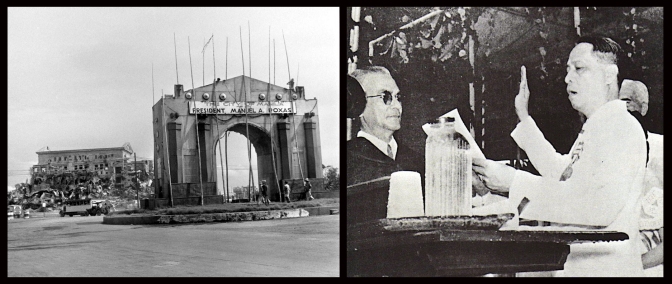
While waiting for the negotiations with the US representative for financial aid in the rehabilitation of the Philippines, Osmeña proposes to the National Assembly to construct a monument to President Quezón. However, Pres. Osmeña was unable to complete any of these projects, as he lost to Manuel Acuña Roxas (1892-1948) in the 1946 elections, on the 23rd of April. As president, Roxas was able to negotiate for the passing of the Public Law 370 of the 97th Congress of the United States, also known as the Tydings Rehabilitation Act by US Senator Millard Evelyn Tydings (1890-1961), which he would sign as on 15th of July 1946 as the Philippine Rehabilitation Act of 1946. Pres. Roxas was only able to have this Rehabilitation Act accomplished by agreeing to sign the Bell Trade Act of 1946 on the 2nd of July 1946, also known as the Philippine Trade Act, which would grant exclusive trade between the USA and the Philippines.


The Philippine Rehabilitation Act saw the creation of the US Philippine War Damage Commission, led by Dr. Frank A. Waring (1890-1969), who would access, review and approve/disapprove financial and technical aid in the rehabilitation and reconstruction of both public and private property that were damaged by the war. Although opened at the end of 1946, the releasing of any payments for public property began in June 1947 and payments for private property began on April 1948. The commission ended its operation in 1951, while the Greater Manila Area was still in the middle of its reconstruction.

The signing of the Bell Trade Act was timed to be executed two days before the Philippine Independence ceremonies, to ensure that Pres. Roxas may announce the impending passing of the Philippine Rehabilitation Act during the ceremonies. Amidst the parades and fanfare, the Philippine was represented by former-president Osmeña and Pres. Roxas, while the USA was represented by General Field Marshal Douglas Hardy MacArthur (1880-1964) and Ambassador Paul Vories McNutt (1891-1955). With the signing of the Treaty of Manila, between Roxas and McNutt, in representation of the US President Harry Shipp-Young Truman (1884-1972), America relinquished its sovereignty over the Philippines. This was symbolized by simultaneous lowering of the American flag and the rising of the Philippine flag over the Luneta Park. The selection of the 4th of July was planned by the American government, to coincide with its own Independence Day when the thirteen American colonies declare independence from British Rule on the 4th of July 1776.

At the end of the war, many government and private institutions that were devastated by the Battle of Manila started purchasing properties in Quezon City and began their exodus from Manila. The University of the Philippines had opened its Dilimán campus in 1949. However, the move of the University of the Philippines had already started in 1940, with the plan presented by Arch. Louis Croft to Pres. Quezón. Croft would coordinate with Arch. Juan Marcos Arellano, who was designing the buildings of the colleges of Law and Education; and with Juan Felipe Nakpil (1899-1986), who was designing the administrative building, Carillon Tower and library. With Arch. Croft focused on the reconstruction of the whole Manila, Pres. Roxas approached Arch. Cesar Homero Rosales Concio Sr. (1907-2003) to oversee the planning and reconstruction of the university.
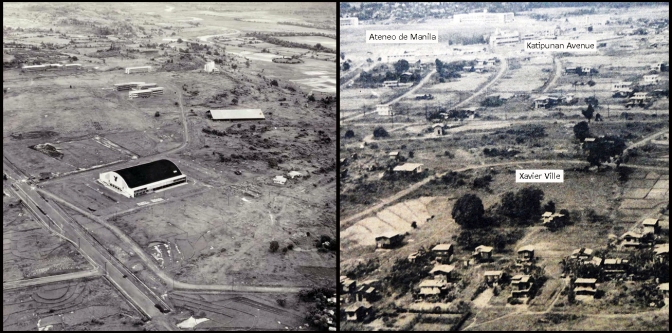
On Katipunan Avenue, the Ateneo de Manila University opened in 1949, and was followed by the Maryknoll College in 1952. With the move of these schools to Quezon City, a large transient population grew around the eastern Dilimán area, with the erection of dorms and boarding houses in the vicinity of the schools. Many families of these students also relocated to the area, and started building subdivisions in the neighborhood.
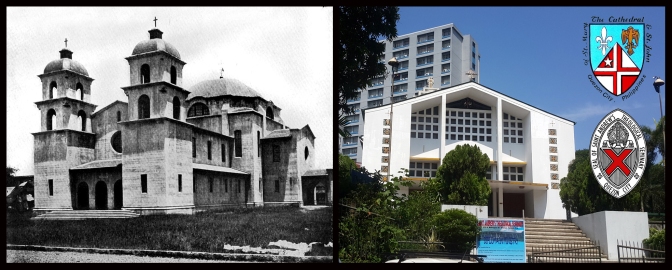
At the España Boulevard Extension (Eulogio Adona Rodríguez Sr. Boulevard), the Episcopal Church moves its St. Andrew’s Theological Seminary in 1947, followed by the Cathedral of St. Mary and St. Johnin 1960, and the Saint Luke’s Hospital in 1961. Along Banawe Street, the Sisters of the Immaculate Heart of Mary (ICM) transfer their Queen of Peace Convent and St. Theresa’s College (STC) in 1947. And in in the Santa Mesa section of Aurora Boulevard, the Daughters of Charity of St. Vincent De Paul’s Collegial De Santa Rosa (now the Immaculate Heart of Mary College) began operations in 1949.

Of the seven great churches in Intramuros, only one survived the bombing of Manila. Joining the migration towards Quezon City, the Order of Friars of the Capuchins built their Our Lady of Lourdes Parish in 1952 in the Santa Mesa Heights, the Dominicans erected their Santo Domingo Church in 1954 along the Quezon Boulevard Extension (now Quezon Avenue), and the Augustinian Recollects opened their San Nicolas de Tolentino Church in the Congressional Village in 1975. Other religious institutions that left Intramuros were the Franciscan Madre de Dios de las Monjas de Sta. Clara’s Monasterio de Santa Clara that opened in 1950 along the Maikina-Infanta Highway (now Aurora Boulevard), while the La Cofradía de Hermanas de Religiosa de la Virgen María transferred its RVM Mother House to New Manila and its Saint Mary’s College to the Homesite Project 1 in 1950. The move of these churches, and the establishment of new parishes, creates centers of interaction and turning these relocation neighborhoods into thriving communities.

Aside from the transfer of Christian institutions, the Poh Chong Temple was established in 1948 in Cubao, to fulfill the requirements of the growing Chinese Buddhist community in Quezon City. Located along Conrado Francia Benitez Street, served the Filipino-Chinese residents of New Manila and the relocating Filipino-Chinese families in Santa Mesa Heights, 5 kilometers away to the north.

Pres. Roxas initiates the revival of Quezón Homesite’s Project, and expands the relocation houses in the barrios Obrero and Kamuning, which would be later known as Barangay Roxas. Roxas also tries tapping Arch. Arellano to continue the construction of the Quezon City plan, as envisioned by Harry Frost, but Roxas is unable to see any of these plans come to file, as he suffers a fatal heart attack on the 15th of April 1948. Roxas’ vice-president, Elpidio Rivera Quirino (1890-1956), is sworn in on the 17th of April.

The problem with the rebuilding of Manila and the relocation of its residents to Quezon City was that most of the public transport was destroyed by the war, including the train system that connected the cities and provinces. As a temporary solution, Army had to use its trucks to act as buses as public transport, while the government tried to gather funds to build a new transport system. A former US military lieutenant, Harry Solomon Stonehill (born Harry Steinberg, 1917-2002), saw an opportunity by using his former military logistics connections to acquire the surplus United States of American military General Purpose vehicles, or GPs (geeps or jeeps for short) that were left in the country at the end of the war, and sell these to Filipinos in the black market. The Jeepneys were decked up American Willy’s MBs and the Ford GPWs, much like the autocalesa of the 1920s to 1930s. Stonehill used his earning from his surplus business to build seventeen businesses, including the Atlas Cement Corporation, the Republic Glass Corporation, United States Tobacco Corporation, the Philippine Tobacco Flue-Curing and Redrying Corporation, the United Housing Corporation, the Philippine Cotton Corporation, American Asiatic Oil Corporation, the Republic Estate Corporation, the Merconsel Corporation, and Far East Publishing Corporation (The Evening News), which helped jumped start the Philippine economy and industry, after the devastation of the war. However, accusations of bribery and corruption led to an investigation by the US FBI (Federal Bureau of Investigation) and Secretary Jose “Pepe” Wright Diokno (1922-1987), with the Department of Justice and the National Bureau of Investigation (NBI). This forced President Diosdado Pangan Macapagal (1910-1997) to sequester all of Stonehill’s assets, and exile him, before a formal hearing could be made.

Another enterprising individual, Demetrio Muñóz (1917-1961), also used his government connections to import the German MAN Nutzfahrzeuge AG MKN series buses, and set up the DM Buslines. By the 1950s, Muñóz also purchased the French Peugeot 403’s and 404’s and German Borgward Isabellas to serve as part of his taxi fleet, which were all housed in a garage in Balintawak, which is now the Muñoz Public Market along EDSA. Other entrepreneurs took Muñóz’s lead, and the late 1940s transport companies such as the JD Transit of Vicente Antonio Heras (1894-1978) and the Philippine Rabbit Bus Lines of brothers-in-law Florencio P. Buan and Ricardo de Lara Paras ply the Greater Manila roads by 1947. And with the construction of the Homesite Project 4, the 1930s Hailili Bus Company relocates it garage to a lot along Aurora Boulevard, to ply the Manila-Marikina route.

In 1948, Mayor Bernardo erects the Welcome Rotonda at the intersection of the Quezon Boulevard Extension (now Quezon Avenue), the España Boulevard, the España Boulevard Extension (now the Senator Eulogio Adona Rodríguez Sr. Boulevard), and Mayon Street; which marks the boundary of Quezon City and Manila. Designed by Luciano V. Aquino, the Welcome Rotonda also celebrated Pres. Quirino’s Republic Act No. 333 that further defined the borders of Quezon City, as enacted on the 17th of July 1948. Sadly, Mayor Bernardo would could to serve for less than one year, as he was killed by the Communist Hukbalhap on the 28th of April 1949, when he was accompanying Quezón’s widow, Doña Aurora Antonia Molina Aragón Quezón (1888-1949), to Tayabas. Pres. Quirino appoints Nicanor A. Roxas, followed by Ignacio Santos Diaz, as acting mayors of Quezon City. In 1950, the Marikina-Infanta Highway is renamed as the Aurora Boulevard, after the beloved first lady.

Pres. Quirino aggressively pursues the implementation of Homesite Program, opening the relocation residential Project 2 and Project 3 in 1950, and Project 4 in 1953. Following his predecessor, Quirino consults with Arch. Arellano, and they build upon Arch. Frost’s plan for Quezon City with a “Plaza of the Republic” elliptical park and the Dilimán Quadrangle road plan, with the three branches of government house in housed within the “Constitutional Hill” rotunda complex. While the Quezon City Master Plan was still in its planning stage, Pres. Quirino and Mayor Diaz saw the start of the construction of the Quezon Memorial and Parks & Wildlife Center in 1952, and the completion of the Quezon City Jail in 1953.

Quirino’s plans for Quezon City were not fully realized, as he would eventually lose to Ramon del Fierro Magsaysay (1907-1957) during the November 10 elections of 1953. However, Pres. Magsaysay would respect the works of his predecessors, from Quezón to Quirino, and push for the continued development of Quezon City in line with the master plans of the architects Frost, Croft and Arellano. To do this, Magsaysay appoints Arch. Anselmo T. Alquinto (born 1905) as the Director of the National Planning Commission (NPC), 1954. Alquinto coordinates with Arch. Cesar Concio Sr. as his consultant for drafting the executive plan to enact the master plan; and see the completion of the Veterans Memorial Medical Center in 1955. At the same time, Magsaysay continues the Homesite Program, and builds the relocation communities of Project 5 to 8, between the years of 1953 to 1957.

By the start of the 1950s, industrialist José Amado Araneta (1907-1985) starts negotiations the to purchase the Cubao property of the Radio Corporation of America (RCA) and the Tuason clan. The RCA had been renting its land from the Tuason family before the war, and had cleared much of it the former farm lands to erect six radio transmitter towers. Araneta obtained both properties by discussions with the Tuason matriarch Doña Maria Teresa Eriberta De La Paz Tuason (1867-1951), as mitigated by her relative Judge Pedro Tiangco Tuazon (1884-1961). In 1952, Araneta starts with a 4 hectare lot, in which he constructs his “Bahay na Puti” (White House) family mansion. In 1954, Araneta starts developing the 31 hectare area to become the Araneta Commercial Center.
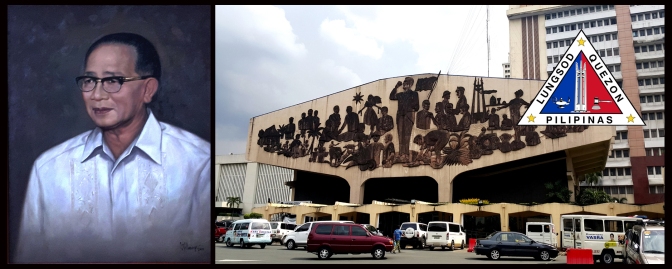
Pres. Magsaysay is also unable to see his plans for the Philippines and Quezon City fully realized, as he would perish in a plane crash on Mount Manunggal in Cebu, on the 17th of March 1957. Despite the death of Pres. Magsaysay, the development of Quezon City as we know it laid on the hands of Mayor Norberto Salandanan Amoranto (1907-1979), who was appointed in 1953, and was the first elected and longest serving mayor of the city and serving from 1954 to 1976. Mayor Amoranto would see the construction and completion of the new Quezon City Hall in 1972, which would invigorate the city and the inspire the government of President Ferdinand Emmanuel Edralin Marcos Sr. (1917-1989) to complete the a semblance of the Frost master plan, and the see the construction of the Quezon Memorial Shrine more than two decades since work began.

The Quezon City Planning Team 1945-1955

Arch. Juan Marcos de Guzmán Arellano (1888-1960) is known as one of the Philippines’ founding fathers of architecture. He finished his studies at the Ateneo Municipal de Manila in 1908; while taking art lessons under noted masters Lorenzo Leogardo Guerrero (1835 -1904), Toribio Asona Antillon (1856-1913), and Fabian de la Rosa. When most people thought that he would pursue a full time career in the arts, Arellano decided to take architectural studies at the Drexel Institute in 1908, and further architectural studies at the Académie des Beaux-Arts. However the draw to painting could not be resisted and he to additional art studies at the Pennsylvania Academy of the Fine Arts in 1911. As an architect, Arellano is most noted for Manila’s Metropolitan Theater (1935), Executive House (1926, now houses the National Museum of the Philippines), the Manila Post Office Building (1926), and Jones Bridge; where he had employed both the Neoclassic styles recommended by the American government and the Art Deco style pushed by Filipno modernist thinkers.

Arch. Anselmo T. Alquinto (born 1905) was a landscape architect, who was known as the head of the post-World War II rehabilitation of Philippine cities during the term of Pres. Ramon del Fierro Magsaysay (1907-1957). Alquinto took his initial architectural studies at the Harvard University, USA. After his studies, Alquinto returned to the Philippines, working in different firms to build his reputation, until his appointment as the Assistant to the Director of Regional Planning of the National Urban Planning Commission under Pres. Sergio Osmeña Sr. (1878-1961), in 1946. After years of government service, Alquinto finally appointed by Pres. Magsaysay as the Director of the National Planning Commission (NPC) in 1954. On the same year, Alquinto took on the responsibilities of planning the rehabilitation of the historical Intramuros district of Manila, which was severely damaged in the war. As director of the NPC, Alquinto was also tasked to lead the International Federation for Housing & Town Planning of the World Health Organization, also in 1954. In the same year, Alquinto was tasked to the design the layout of the Quezon Memorial Park, while the Director of Public Works, Arch. Federico S. Ilustre (1912–1989), designed the Quezon Memorial. In 1955, Pres. Magsaysay appoints Alquinto as part of the Tagaytay Development Commission. After the death of Pres. Magsaysay, Alquinto returned to America to take his master’s degree in landscape architecture at the University of California, Berkeley. Upon his return to the Philippines, Alquinto was selected by Pres. Diosdado Pangan Macapagal Sr. (1910-1997) to continue the design of a new national capitol in Quezon City, which was previously assigned to Arch. Ilustre in 1963. However, Alquinto did not complete the project due to budgetary constraints. Afterwards, Alquinto accepted the position of Dean of the School of Architecture at the Mapua Institute of Technology. And in 1977, Alquinto would join other landscape architecture pioneers to organize the Philippine Association of Landscape Architects (PALA) in 1977.

Arch. Cesar Homero Rosales Concio Sr. (1907-2003) first graduated with bachelor of science degree in civil engineering at the University of the Philippines in 1928, and then took up architecture at the Mapua Institute of Technology in 1932. In 1933, Concio ranked first in the government examination for architects. Later on, he studied his masters in town planning, and housing at the Massachusetts Institute of Technology, in 1940. Upon returning to the Philippines, Concio started working at the Department of Public Works, from 1940-1945, while teaching at Mapua. By 1946, he headed the Department of Architecture of Mapua, and became its first dean. In 1948, the Capital City Planning Commission was created, and Concio was appointed executive secretary. He is also a president of the Philippine Institute of Architects (PIA). In 1969, Concio was given the Patnubay ng Sining at Kalinangan by the City of Manila.
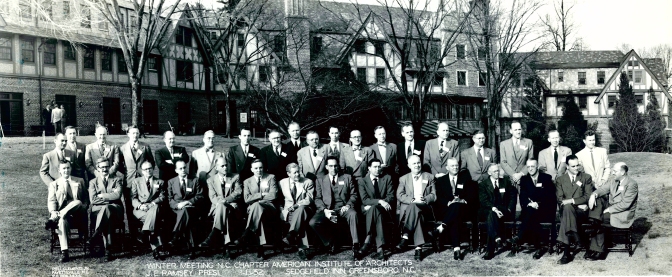
Arch. Louis P. Croft (1900-1978) was an American landscape architect and planner, who trained under Warren Henry Manning (1860-1938) who was a leading proponent of Regional Planning in America. In 1934, Croft would build his reputation as a landscape architect of the National Park Service (NPS) in North Carolina, before joining the Civilian Conservation Corps and sent to the Philippines to work under the Bureau of Public Works, under Alpheus Daniel Williams (1887-1945); where helped develop the National Parks Office of the Philippines. Croft was recruited by Williams to be part of the team that would plan the new capitol city of the Philippines, but they were unsuccessful in completing their plans when the Japanese invaded the Philippines in 1941. Croft was arrested and detained in Santo Tomas Internment Camp, with his wife Lois, the principal of the American School, Manila. After the war, Croft remained in the Philippines, acting as the 1945-1946 Chief of City Planning under President Sergio Osmeña Sr. (1878-1961), then as the 1947 to 1949 Manila Planning Commissioner and advisory staff for Land Planning under President Manuel Acuña Roxas (1892-1948); where he worked in the Manila Electric Company City Planning and the Philippine Safety Council in 1947, and Director of Traffic for Manila in 1948. In 1950, Croft left the Philippines to take a long vacation touring Java, Bali, Singapore, India and Europe; before returning to America to work as the chair of Urban Planning Salt Lake City, the head the landscape planning of the Grand Canyon in 1955. Upon his retirement in the 1960s, Croft and his wife gave talks around the US about the atrocities of the Japanese concentration camps.

Eng./Arch. Antonio Cruz Kayanan (1911-1988) was born in Victoria, Tarlac, and migrated to Manila to take his collegiate studies at the University of the Philippines, taking both architecture and engineering. Kayanan then went to the USA to complete his advanced studies at the Massachusetts Institute of Technology (MIT) in 1942, and became the 1st Filipino Urban Planner and he was a registered American architect with the license number OH: DC AIA 1944-1949. While in America, Kayanan met up with the exiled President Manuel Luis Molina Quezón (1878-1944), and joined his Technical Committee on American-Philippine Trade Relations in 1944. After the War, Kayanan returned to the Philippines and was asked by President Sergio Osmeña Sr. (1878-1961) to work with Arch. Louis P. Croft (1900-1978) in planning the reconstruction of Manila and the development of the circumferential roads that would link Metro Manila with the outlying provinces. Kayanan would continue his work on urban develop under President Manuel Acuña Roxas (1892-1948), while teaching at the Adamson University’s College of Architecture and establishing the U.P. Alumni Engineers in 1947. In the 1950s, Kayanan returned to the USA and worked for the Regional Association of the city of Cleveland; and he also became a consultant to the United Nations on Tropical Housing, adviser of the Costa Rica National Institute of Housing and Urbanism (INVU) by 1954, and adviser of the Puerto Rico Planning Board by 1960. When Diosdado Pangan Macapagal Sr. (1910-1997) was elected as President of the Philippines, he called Kayanan to return and appointed him as the Chairman of the National Planning Commission. After Macpagal’s term in 1965, Kayanan went into private practice, with his Harvard educated architect brother, Maurice; who had formed the Jeka Development Corporation with their sons in 1972. In 1973, President Ferdinand Emmanuel Edralin Marcos Sr. (1917-1989) called Kayanan back to civil service, to be part of the Board of Consultants for the Task Force on Human Settlements. After his work for Pres. Marcos, Kayanan retired from public service.


31 thoughts on “Quezon City: Post-World War Quezon City and the Reconstruction 1945-1957”